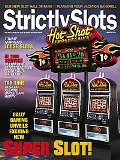
Strictly Slots
The History of Progressive Slots
During the single decade of the 1980s, slot machines went from being ancillary casino offerings surrounding the central attraction of table games to the single offering responsible for seven of Frank Legato is recognized nationally as an expert in the history and operations of slot machines. He regularly conducts seminars for both the professional trade and the playing public. Frank shares his 20 years of researching, writing about, and playing the slots in his book How to Win Millions Playing Slot Machines! ... or Lose Trying. every 10 dollars in gaming revenue the average casino rakes in. The reason for this transformation was simple: The jackpots got larger. The prospect of winning big money on a game that required little or no gambling knowledge to play was the main cause of the phenomenon that led to the machines outstripping the tables as the top casino draw.
Frank Legato is recognized nationally as an expert in the history and operations of slot machines. He regularly conducts seminars for both the professional trade and the playing public. Frank shares his 20 years of researching, writing about, and playing the slots in his book How to Win Millions Playing Slot Machines! ... or Lose Trying. every 10 dollars in gaming revenue the average casino rakes in. The reason for this transformation was simple: The jackpots got larger. The prospect of winning big money on a game that required little or no gambling knowledge to play was the main cause of the phenomenon that led to the machines outstripping the tables as the top casino draw.
The reason jackpots got larger was twofold: First, the virtual reel system invented by Inge Telnaus released the games from the constraints of the physical reel. Instead of 22 possible combinations on each reel, which limited the amount of money the casinos could offer as jackpots while still making money on the machine, the computerized slot machine could have as many possible combinations in the program as the programmer desired. Odds of top jackpots became longer, so larger jackpots could be offered. Sure, they would hit with less frequency, but they would still hit—and that possibility brought the dream-seekers in by droves.
But an even larger enticement also appeared during the 1980s, one that prompted countless thousands to give casinos a try for the first time. In the mid 1980s, the nation’s most popular legal game of chance was still, by far, the state lottery. The possibility of a life-changing lotto jackpot was the most pervasive enticement for Middle Americans to gamble, because it offered something casinos, at the time, did not: The prospect of instant wealth from a simple act that required no skill.
It was March of 1986 when International Game Technology introduced this style of instant, life-changing jackpot to the casino industry, in the form of Megabucks, a game that linked slot machines together (at the time, over phone lines via modem technology), with all coins played on machines in the network incrementing a giant pari-mutuel jackpot. IGT seeded each jackpot with its first guaranteed million, and from there, the portion of wagers took over, incrementing the life-changing prize on an electronic meter as slot players pumped in coins incessantly while dreaming of a new life of luxury.
Progressive slot machines grew with the industry, the giant, life-changing prizes eventually being joined by smaller ones that hit more frequently, with interesting bonus features to fill the time while players shot for the big payoff. Wide-area progressive slots like Megabucks were augmented by individual casinos with progressives ranging from a single machine to several banks of linked games.
Progressive slots are now a way of life in the casino industry, and from the smaller linked prizes to the mega-million-dollar payoffs, they are the subject of a continuous quest for knowledge by players: Which ones are the best to play? How is the jackpot decided? Who is responsible for the payoff? How much should I bet? What are the odds? Is there a way to tell when a progressive is about to hit?
Due to the multitude of questions we receive about progressives, I thought a progressive primer would be helpful. In the next article I'll provide some facts behind all the big-money dreams.

